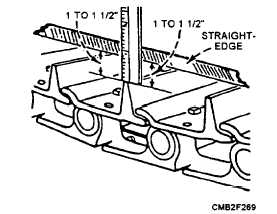MAINTENANCE OF TRACK AND TRACK FRAME ASSEMBLIES
Some maintenance of track and track frames are performed at the jobsite by the field maintenance crew. This maintenance consists of track adjustment, lubrication based on hours as required by the manufacturer, and inspection of the track and track frame components.
Track Adjustment
If the tracks are adjusted too tightly, there will be too much friction between the pins and bushings when the track links swivel. as they travel around the sprocket and front idler. This friction causes the pins, bushings, links, sprocket, and idler to wear rapidly. Friction in a tight track also robs the tractor of needed horsepower.
Tracks that are too loose fail to stay aligned and tend to come off when the tractor is turned. As a result, the idler flanges, roller flanges, and the sides of the sprocket teeth wear down. A loose track will whip at high tractor ground speed, damaging the carrier rollers and their supports. If loose enough, the drive sprockets will jump teeth (slide over track bushings) when the tractor moves in reverse. Should this happen, the sprocket and bushings will wear rapidly.
One method for determining proper track tension is placing a straightedge over the front carrier roller and idler with all the slack removed from the rest of the track. Using a ruler. measure from the top of the track shoe to the bottom edge of the straightedge (fig. 6-28). For the correct measurement, refer to the manufacturer's manual.
If it becomes necessary to adjust the track in the field, the following method can be used. Remove all

Figure 6-28. - Checking track adjustment.
slack from the track. With all slack removed, release the pressure until the front idler moves back 1/2 inch. This will provide the required slack in the track until the tractor can be readjusted to the manufacturer's specifications.
NOTE
Always check the manufacturer's maintenance manual for the proper procedures when adjusting tracks.
Lubrication
The track pins and bushing are hardened and require no lubrication. Many rollers and idlers are equipped with lifetime seals that are factory lubricated and sealed. However, track rollers, carrier rollers, and idlers equipped with grease fittings must be lubricated on a scheduled basis that is set by the manufacturer.
NOTE
ONLY use a hand-operated grease gun on these fittings and pump only until resistance is felt. Further pumping will damage the seals.
Inspection
When performing routine maintenance, inspect the complete track and undercarriage for signs of abnormal wear, leaking rollers or idlers, and misaligned, loose, or missing parts. Should you find any loose track shoes, you should check the torque on all the shoe bolts. Any bolts not meeting specifications should be retightened to the prescribed torque.
If the track appears to be out of alignment, report this to your supervisor who shall determine what action is required. Leaking roller and idler seals should be replaced as soon as possible to prevent any further damage to the equipment.
Shop Repairs
Repairs made to tracks and track frames in the maintenance shop are usually limited to replacing roller or idler seals and bearings or repairing a hydraulic track adjuster. On occasion, you may find a roller or track that is badly worn and requires replacement.
Continue Reading